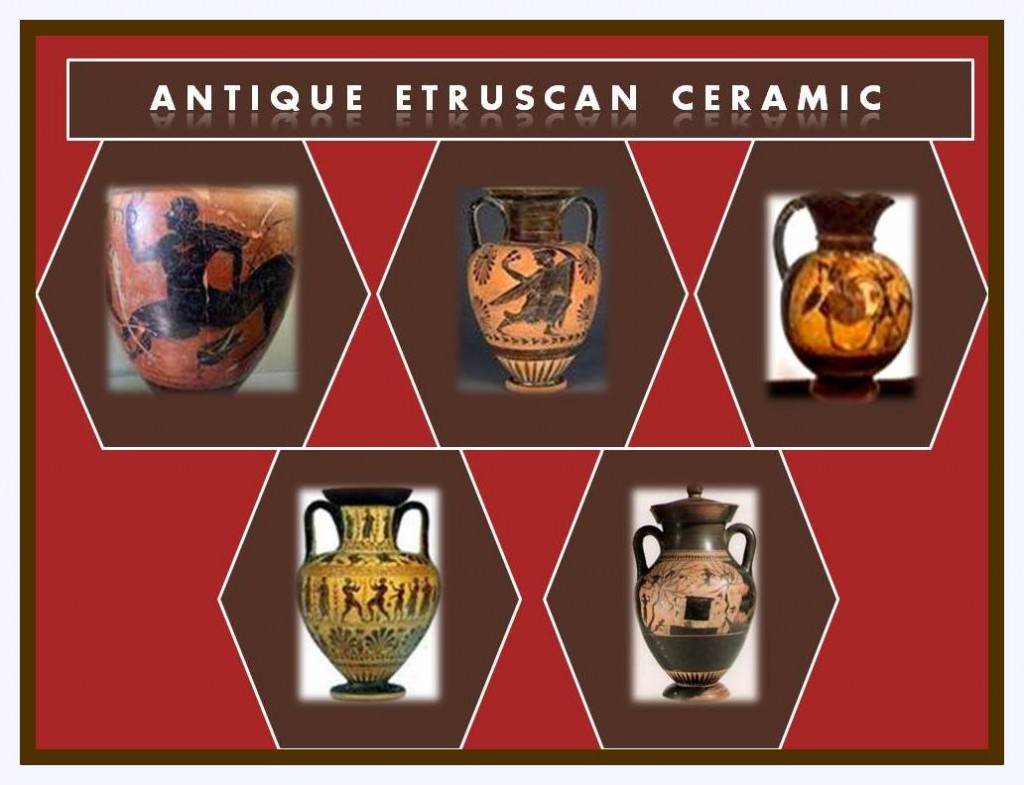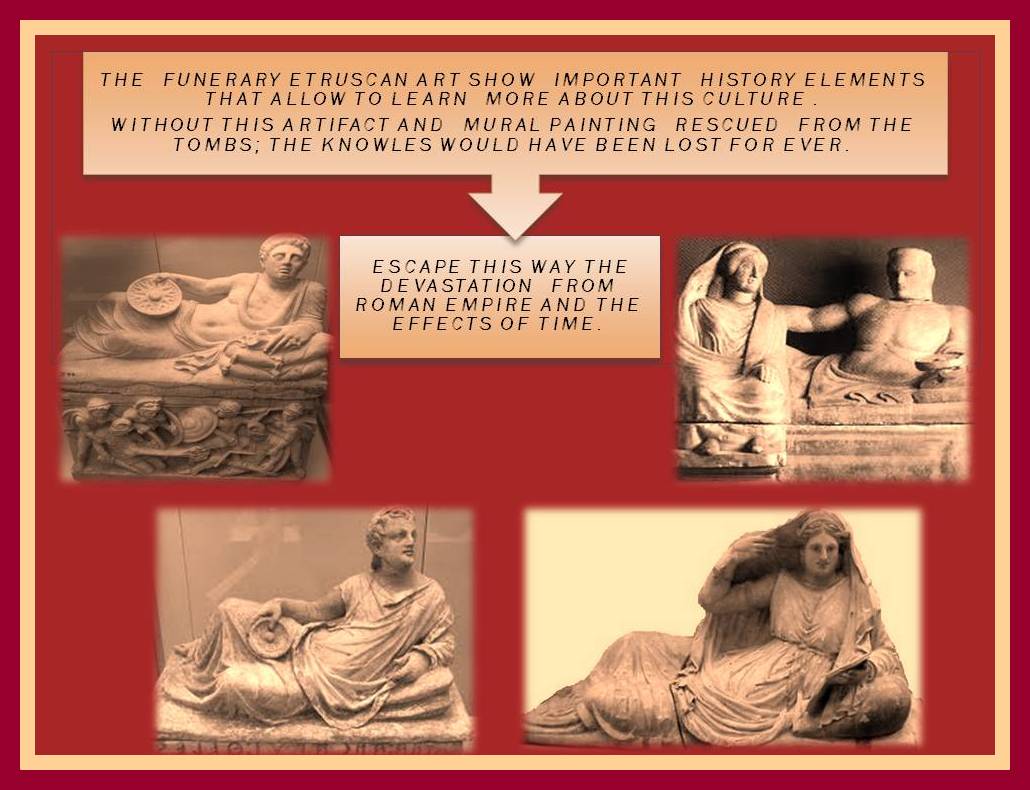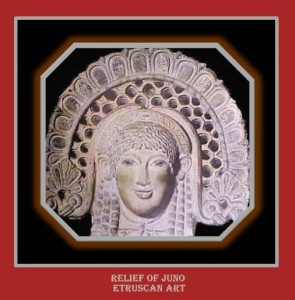Ceramics, Metalwork, Sculpture.
Ceramic
Etruscan pottery terracotta overcoat technique was widely used in sculpture, in the production of masks and decoration of sarcophagi. The most splendid pottery recovered in the necropolis of Etruria were essentially imported from the cities of Greece and the Greece Magna, forming part of the network of exchanges and business between Etruscans and Greeks, but we find that along with these imported works were other local production that mimicked the first, about all those that were carried out in the attic and Corinthian style, which had a price more affordable and economical that the imported. The fact about these works less price did not indicate anything were of lesser quality since it is difficult to distinguish between the imported from the local.
Some ceramic Greek teachers (as Demerito di Corinto) then opened workshops specialized in the major cities of Etruria, disseminating their work systems: they taught how to debug and waterproof clay, also introduced the use of winch, introduced new forms of decoration painted with colors made on mineral bases as well of the popular Greek style ceramic realization. The geometric style is stylized, and goes from being of naturalistic character to offering inspirations based on episodes from mythology.
The most prominent Etruscan ceramic is performed in the technique of Bucchero (derived from the Spanish word Bucaro) which is a ceramic made using a much more refined clay and whose termination is much more polished since they use a rich thin grain of iron. Its texture was fragile and porous, black or dark grey becoming bright and beautiful when they were polished. This type of pottery was produced from the middle of the 7th century BC.
Baking this ceramic in a smoked atmosphere devoid of oxygen to reduced the porosity of the surface of the object to be impregnated of carbon particles. This type of technique was formerly known by other cultures before them, but the Etruscans raise it to a degree of perfection by using refined clay resulting in even more uniform black. This ceramic Bucchero in an initial archaic period of its realization was a bit loaded and tended to be profusely decorated and at the V century B.C the production of these type of ceramic stopped.
Approximately in the year 550 BC black-figure Corinthians pottery was the one that kept dominating the market preference of Etruria. It Is known that master potters from Ionia not only dominated the Etruscan market, but even went on to productions in the same Etruria. The ceramic Caeretan hydrae were extremely important and were made in Cerveteri. Master Athenian potters even export to Etruria a special production line when black-figure pottery and also the red figures began to gain in popularity and demand therefore to dominate the market.
Meanwhile the Etruscan ceramists produced pottery black figures but with great Greek influence in its forms and designs. They later also produced red-figure pottery around the V century BC, but rather doing them following the so-called attic style that was performed in the city of Vulci and Civita Castellany. Glazed Black ceramic came to also have popularity as well as that it produced with silver colors that imitated the metal; very sophisticated these one that were a success in business and were of great demand during the Hellenistic period, producing them in the central region of Etruria.
Sculpture
The Etruscans did not used marble despite its Greek influence in their sculptural productions, however; the terracotta and local stones were widely used above all for the production of bas-reliefs, funeral and religious sculptures to decorate the temples. Sculptures were also produced for the decoration of the houses of the wealthy people who could afford them.

Bronze sculptures
However when they were made in bronze; these sculptures were only for the decoration of religious and funerary theme. The topics of everyday life, or profane nature according to the evidence preserved until now; do not show that they have been prepared using the bronze.
– The highlight of the Etruscan sculpture in bronze was the “Capitoline wolf” made around the 5th century B.C presumably in the first half of this century and whose known image is shown in the article devoted to the history and Etruscan culture on this site.
– The chimera of Arezzo (380 – 360) BC the Greek classical models of Praxiteles and Scopas-related.
– The Marte of Tody. This sculpture shows already elements of Greek classical models of schools of Phidias and Policleto.
Sculptures in terracotta (Coroplastia)
The terracotta was used for elements of architectural production such as
- Plates
- Antefixa (an ornamental edging on the eaves of an ancient building with a tiled roof that hides the joints of the roof tiles)
- Acroterion (an architectural ornament placed on a flat base called the acroter or plinth). Stand out the productions in the city of Caere. The most important example is the sarcophagus of the spouses made in the period around 530-520 BC.
Sculptures of religious and mythological subjects were produced in the city of Veii. As an important example of those productions is The Apollo sculpture around the VI century B.C and is a representation of God’s natural size. Other Etruscan sculptures discovered at the same place of worship in Veii are made with the technique of modeling and archaic representation elements from the influence of Greece and were intended to decorate the top of the temple. Stands out the name of Vulca (Etruscan sculptor from this region of Veii) to who is attributed the statue of Jupiter and Hercules.
The reliefs found mainly associated with funerary art; (Since have not been reached enough samples of decorative reliefs made with different purpose to evaluate them), are composed of funeral steles, cippi and sarcophagi as well as crematories urns and reliefs on the walls. They tell about the life of the deceased and thank to this information we have been able to obtain valuable data related to the Etruscan culture.
Jewelry and metal work of the Etruscan Art.
Stand out in the preparation of refined and original gold and silver artifacts such as pins, bracelets, rings, necklaces, jewelry for personal adornment, house goods decoration, daggers, shields, swords and pectoral; amongst other many items thanks to the metallurgical development reached by several Etruscan cities.
In a first period the archaistic influence from the techniques of master Jewelers of Greece with strong Orientalizante influence stands out in the 7th and 6th BC.
The Etruscan developed wonderful pieces using metal with techniques such as the grain, watermark and embossment. By evidence found in the city of Vetulonia of small unfinished blocks in ivory it is known that there was a local production. Over time the local craftsmen progressively adapted their work to the specific characteristics and taste of the Etruscan Art. A little more freedom in forms were placed but making sure nevertheless that the beauty and perfection of the art pieces remains.
They worked silver and other metals producing various with strong Oriental influence. Some objects as for example metal vessels; made in order to contain wine were reproduced in bronze, as well as other various objects including hand mirrors depicting a few of them mythological scenes as well as scenes of the everyday life. They had in many cases inscriptions with short messages, by this one it can be deducted that the main Etruscan women clients of these mirrors could read, at least the aristocratic woman’s who could afforded.
Etruscan objects for decorative use.
Beautiful objects made of ivory and amber were primarily made for jewelry and other body ornaments like Combs. Some small vessels to contain perfumes and ointments were found. Semiprecious stones cut in required forms to complement the decoration of rings, necklaces and earrings were made with expertise and attention to detail. It still amazes the ability of these master craftsmen who with tools today for us rudimentary, managed objects of so much beauty.
It is true Yes, that the Etruscans had a strong Greek influence in their works of art that they imitated them because they appreciate the perfection of their work and skills; which is perfectly related with the tastes and characteristics of their own culture, but from there to say as others have said; that they were mere imitators without intentions of creating their own style; It really is an injustice to affirm a testimony like that without even have all the elements because many have been lost.
Deny that the Etruscan art would have its own identity by the mere fact they used Greek skills and techniques It is going too far in the waters of ignorance and give too little credit to a culture that it is now that it is beginning to know its history and legacy a little better. The Greek techniques by the way were more than tested to work perfectly fine related to the taste of that period in history and also had great demand thanks to the perfection and beauty with which they were created; so why the Etruscan should not imitated them is they fix perfectly for their purpose? Is not easy to take some other culture techniques and style to make them your own but they overcome the challenge nevertheless with success.



































